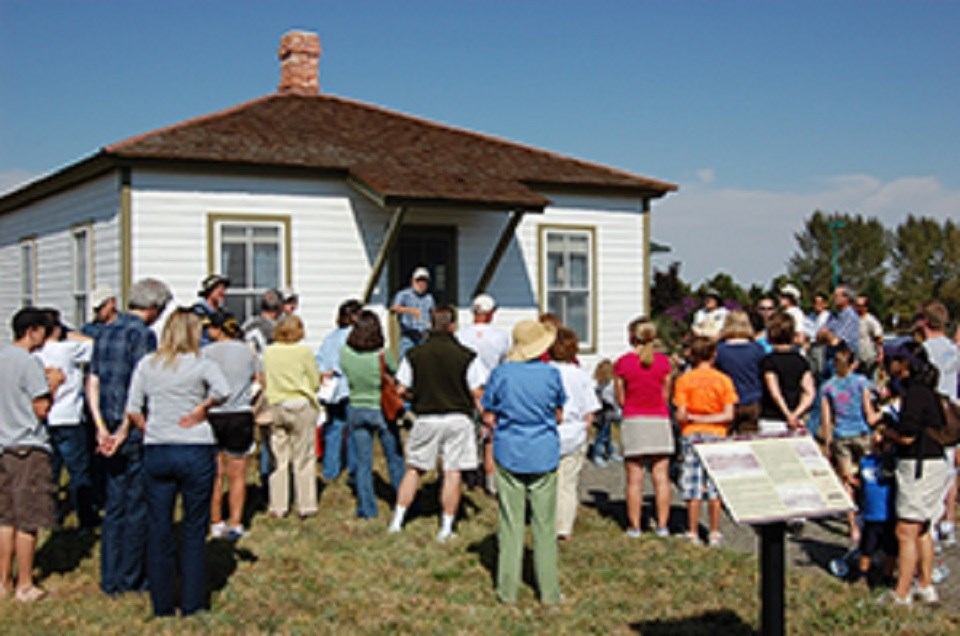History can define and shape a community, so what happens when a community loses artifacts of its history to a disaster? The staff at Superior Historical Museum is exploring how to rebuild after the devastating Marshall fire destroyed the building and most things inside.
When the Superior Historical Commission or SHC was founded in 1999, one of the group’s goals was to organize the scattered elements of Superior’s history into one setting.
It was only fitting for the building which would become the Superior Historical Museum to be a historical artifact itself. Drawing upon Superior’s roots in the coal mining industry, SHC had a house — built in 1908 beside the town’s industrial mine — rehabilitated and moved to a more central location.
According to Larry Dorsey, chair of SHC, the citizens of Superior were delighted when the town’s first historical museum was born in 2010, especially the longtime inhabitants of Original Town Superior who appreciated seeing items which they had grown up with on display, Dorsey said.
Over time, the museum came to tell the lengthy, multifaceted story of Superior to residents and visitors alike. It created a sense of community within the town and even managed to unite the people of Old Town with those living in the Rock Creek area, Dorsey said, a zone where Superior’s newcomers tend to settle.
“Some of the people in Rock Creek coming from out of state aren’t familiar with the local history,” he explained. “They would come to the museum and say ‘I didn’t know there was a coal mine here.’ People from Rock Creek and Original Town would be there learning and communicating with each other… so that is a big loss to come from the fires.”
On Dec. 30, the Superior Historical Museum became a casualty of the Marshall wildfire.
Although SHC’s effort to consolidate the city’s historical artifacts into one space in the early 2000s had been well-intentioned, the loss of the museum came as a devastating blow for Superior, its citizens and the accounts of its history.
“What we had in the museum was kind of all (the historical remains) there were,” Dorsey said.
In the event of a disaster, Colorado Cultural and Historic Resources Task Force, or CCHRTF, is responsible for providing assistance to local cultural or historical resources in the areas where the disaster poses a threat, according to Christina Cain, chair of CCHRTF.
“In response to the (Marshall) wildfire, (CCHRTF) immediately reached out to (Dorsey) and to the Louisville Museum while the fire was active to see what their situation was,” Cain said. “With some fires, like the ones in 2020, we had enough time to evacuate the museums. In this case, we obviously did not.”
Although CCHRTF offers support and advocacy services to SHC as they continue navigating the aftereffects of losing the museum, Cain recognizes the profound impact this kind of historical loss has on a community’s sense of self.
“(Historical) things are often unrecognized in the way that they are really really important to the identity of a given community,” Cain said. “The (Superior Historical Museum) held the collective history and memory of Superior which gave it that core culture and identity. When that museum was lost and most of the town’s history … that’s very difficult.”
Despite the negative economic effects associated with the loss of the historical museum, Dorsey declared, “there are some things you can’t put a price on, and the sentimental value and sense of community of the museum are not the same as dollars and cents.”
While the building and artifacts will undoubtedly look different in the new, future version of the Superior Historical Museum, the clean slate presents SHC with an opportunity “to be more all-inclusive as a historical museum and show that history doesn’t just take place in the 1800s – history is happening right now,” Cain pointed out, “and that this disaster is now a part of that history.”
Although SHC has some way to go before they can begin the process of replacing the fallen historical museum, CCHRTF has been helping them build a photo archive of the collections the Superior Historical Museum once held, as well pictures of what the town used to look like and what it looks like now after the wildfires, according to Cain.
To present an even more inclusive version of history in Superior’s eventual replacement museum, SHC is considering a collaboration with the Museum of Boulder and the Louisville Historical Museum to build a shared museum collection dedicated to the Marshall and Middle Fork fires.
“This piece of history could be part of a story (Superior, Boulder and Louisville) share,” Cain said. She considers support, connection and communication between the neighboring cities as positive efforts toward preserving and creating the history of Boulder County.
“On one hand, (the loss of the Superior Historical Museum) is crushing,” Dorsey reflected. “But, on the other hand, now we get to reinvent the whole thing.”
The wildfires’ diminishing impact on Superior’s history helped Dorsey and Cain identify practical methods they can use to become better custodians of local culture and history.
“(SHC) learned a huge lesson: back up your data in a cloud or some other place,” Dorsey remarked. The fire ruined the sole computer hard drive SHC had employed to keep copies of the Superior Historical Museum’s collections.
Cain agreed,“I think the database lesson is huge when we think about protecting history.” Additionally, “what other museums, libraries and archives can take away from this is that they are the keepers of culture and they have an obligation to prepare for emergencies, whether that emergency is a leaky pipe in their building or something really devastating. They should think about how they can protect this history and be a proper steward of this culture,” Cain said.
Correction: Raw Creek has been corrected to read Rock Creek.



